
 |

|
|
|
|
Name: AKA
Marion, Marianne. Height: 5' 1" (1,55 m) Weight: 106 pounds (48 kg) Eyes: brown Hair: titian Marriages: (1) Gordon Barry Thomson, actor (Feb 15. 1934 - Jan 1938, divorced) (2) George Zachary, director, producer (Oct 5. 1939 - ca. 1945, divorced) (3) Bud Collyer, actor (aka Clayton Johnson Heermance, Jr.) (Sep 28. 1946 - Sep 8. 1969, his dead) Children (from Bud's first marriage to Heloise Law Green): Patricia Collyer (Mrs. John Zavitz) (ca. 1939 - 1940) Cynthia Ann Collyer (ca. 1940 - 1941) and Michael C. Collyer (ca. 1942 - 1943) Sister: Eleanor Ione Shockley Udell (Apr 28. 1919 - Jun 30. 1979) |
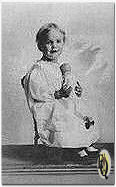 |
| Above right: A picture of a young Marian Shockley (ca. 1911) | |
|
Born Marian Metier Shockley
in Kansas City, Missouri on October 10. 1908 to Percy Ambrose Shockley, a lawyer, and Lottie
Laura Metier. As graduate of Northeast High School she started majoring in history at the University of Missouri where she was a proud possessor of a Kappa Alpha Theta pin. In 1929 she received her A.B. degree. During her stay at the University of Missouri, Miss Shockley was a familiar figure in Workshop productions. The 1929 Savitar, reviewing the Workshop play, The Enchanted Cottage, related: "Marion Shockley playing the feminine lead, was instrumental in building up the play with her delightfully charming and natural acting... she brought life into an otherwise poor first act... to prove herself most worthy of the lead." Clearly a beautiful girl while co-ed at University Marian was selected Queen. In the spring of 1930 went to Hollywood in the family car with her mother and a girl relative. She took crossing half the continent as a matter of course and drove almost the entire distance to California. Upon arriving a relative asked if she'd like to see a movie studio. So five days after she arrived she went into the Metropolitan studios as a sightseer. On the first sound stage she visited was Marshall Neilan directing Alice White in a scene for Sweethearts On Parade (1930) for Columbia. Neiland noticed Marian as "cute little blonde" and called her over. "How would you like to work in the picture?” Neilan said point blank. "Oh,” said little Marian, "all right, I guess—but the studio’s awfully far from our apartment in Santa Monica.” "It’s half past three now,” he said. "I don’t believe we could move the studio by morning—but I’m not kidding—if you’d like to do a bit before the camera tomorrow, I’d be glad to have you.” She laughed and said, "All right." He bustled away to Al Christie's office. "Al," he said, "I've just seen the strangest thing that ever was in Hollywood. A good looking girl that doesn't want to get into the movies. She ought to be in. Take a look at her on the set tomorrow." The next day at 8:30 o'clock Miss Shockley was on hand. "How would you like to be the leading woman in 'The Freshman's Goat?' " the producer began portentously. "The what?" " 'The Freshman's Goat' it's a college picture." "But - you see- I've been to college - I don't believe I could qualify." "I think," Mr. Christie said, smiling, "that Nat Ross can overcome that." And so Marian became Little Fannie Campus in the movies and that why she claimed to be the only girl in Hollywood's history who walked into a movie studio with a pass on a sight-seeing tour and come out with a signed contract. |
|
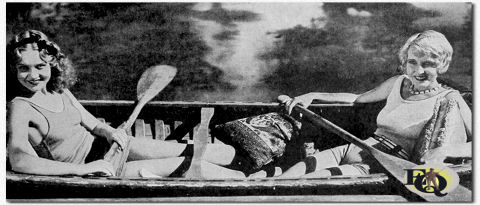 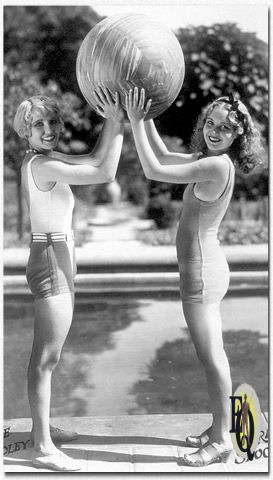 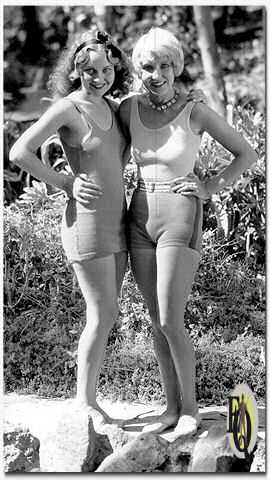 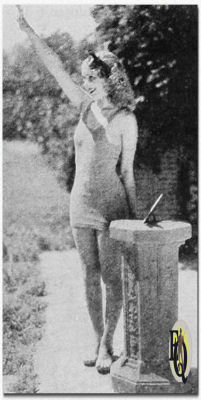 Above: Two pretty stars of Educational comedies, Marian Shockley and Estelle Bradley, pose for a summer scene. If you live in the blustery portion of America, forget your chills and think of these pleasant California moments. Part of a series of photos "Bathing Beauties Stars". |
|
| On July 15. 1930 nine prominent names were added to the Educational-Metropolitan star line-up. A collegiate flavor was given to A Vanity Talking Comedy, Christie-Educational (two-reelers) series at the outset, not only by the title of the first release The Freshman's Goat (Sep 7. 1930), but also by its cast, Marian Shockley and Ray Cooke, who had featured parts, were both members of national college fraternities. Direction was in charge of Nat Ross. | |
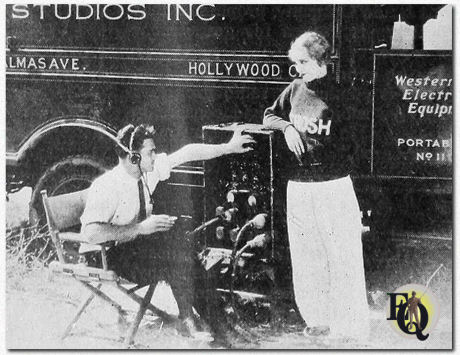 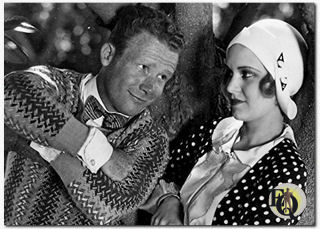 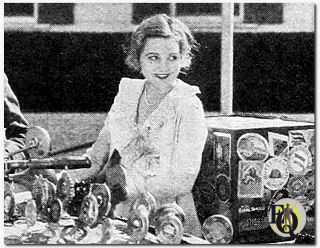 Top: Wonderful photo of the Western Electric portable sound truck in action during filming The Freshman's Goat. The mixer Donald Peters, picking up the voice coming over the mike, is shown next to Marion Shockley who plays the feminine lead. Above left: 1930 Add for Vanity comedies. "Watch 'em step! How those boys and girls can make whoopee! A Freshman-Sophomore battle isn't in it for action by comparison with these comedies of youth. With Ray Cooke and Marian Shockley supported by a big cast you'll find plenty to bring the laughs in The Freshman's Goat." Above right: Gyula Bartha and Zoltan Sulkowsja, who left Budapest two years ago to see the world from a motorcycle, as they paused in their travels at the RKO-Pathé studio, where Marion Shockley, comedienne, thus added charm to their stay. (Book Readers Image, May 30. 1931) |
|
|
From 1930 until 1934 she played in some 19 B-movies (mostly 2 reels shorts). Little Beau Peep was the tentative title of the first comedy in a new series produced for Educational at the Metropolitan studios (Sep 13. 1930). The comedy features Buster West and his father, John West. In the supporting cast are Vera Marsh, Carol Wines, Vera Steadman, Marian Shockley and Iris Adrian. The Vanity Talking comedy was based on an original story by Jimmy Starr. An amateur detective was employed by the D.A. to trail a gunman's moll. He got the girls mixed up and followed the DA's daughter by mistake. William Watson directed. It was eventually released under the title Don't Give Up (Oct 26. 1930). A promising young performer at Educational, she was contracted by director David Graham Fisher in August 1930 for the lead role in The Missing Witness, the original stage production by Ramon Romero and Harriet Hipsdale, which would play at the Egan Theatre in New York. Egan, which produced the play and appeared in the lead role, received permission from Educational to use Marian's services on stage. The audience witnessed the trial in which three women stood trial for the murder of a famous surgeon Lugosi. Leading a large cast were Maude Fealy, Gloria Grey, Harry Stafford, Ricca Allen, Marion Shockley (who played Betty Young, one of the accused women) and others. The Laughback (aka Let's Go Pigskin, Universal), with Monte Collins, Marion Shockley, Dick Alexander, Jack White, Pitzi Katz, and Russ Saunders was a 2 reels Red Star Comedy directed by Stephen Roberts. Released December 24. 1930 it tells the story of a dumb football player who wins the game anyway. Some critics called it "Somewhat behind the times". Two would-be Romeos are suitors for the same co-ed in College Cuties (aka Tearing to Go, Christie Film), with Marion Shockley, Eddie Tamblyn, Iris Adrian, Ronny Rondell, and Stella Adams. This (2 reel, 19 min.) Vanity Talking Comedy was directed by Nat Ross and was released December 28. 1930, and was said to be a "fair comedy about the kind of college life everyone would like to lead”. In February 1931 Pathé started on Parents Wanted, by Margaret Echard, adapted and directed by Fred Guiol, with Edward McWade, Marion Shockley, Ethel Wales, Al Austin, William Janney and Harold Goodwin. |
|
|
In Disappearing Enemies (A Folly Comedy, RKO Pathé,
2 reels), with Edward McWade, Dot Farley, Arthur Hoyt, Martha Maddox,
Rex Bell and Marion Shockley, the aunt and uncle
of two newlyweds carry on the quarrels they've had for years.
(Release: Mar 1. 1931) Right: Marion Shockley and Rex Bell go in for domesticity in a big way in Disappearing Enemies (1931). |
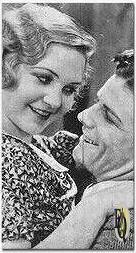 |
|
A campus tutor accidentally tacks
a quarantine sign on the house where students are partying in Open House,
with Nat Carr,
Nick Stuart, Kane Richmond, Claire Du Brey and
Marion Shockley, this was a 2
reels Campus Comedy, RKO Pathé, directed by Harry Fraser (Release: Mar 22. 1931). By February 1931 she'd signed a contract at Universal. She was seen in The Last Back and No Privacy. She also played a nurse in yet another short Hello Napoleon (Universal, June 3. 1931). Marion Shockley became the girl, the daughter of a rich promoter who was interested in a fire-extinguisher invention of the hero. She co-starred opposite Tim McCoy in the 12 chapters long serial Heroes of the Flames (ca. 20 min each, Universal, Mar/Jun 1931). She was Bob Steele's leading lady in Near the Trail's End (Tiffany, Sep 30. 1931), directed by Wallace Fox. This was the last of eight Westerns Steele did for low-budget company Tiffany and the only feature film to co-star Marion Shockley. |
|
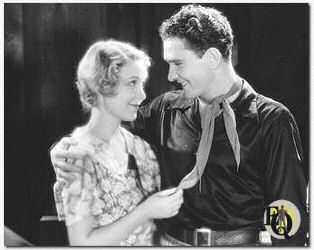 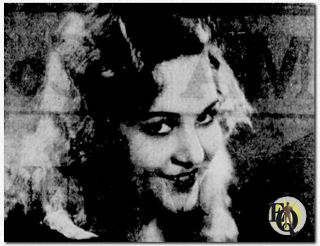 Above left: Bob Steele and Marian Shockley in Near the Trail's End (Tiffany, Sep 30. 1931) Above right: Greetings from Marian Shockley, ingenue with the Ketcham-Cleveland Company, opening at the Denham Theater Sept. 12 in the famous comedy "That's Gratitude." (Intermountain Jewish News, 1931) |
|
|
On September 12. 1931 Denham's Theater, Denver opened with That's
Gratitude, Frank Craven's comedy. Marion Shockley played the beautiful
but dumb Lelia with great success. With this, Ben Ketcham and George
Cleveland began a stock company for which Marion was contracted and went on
to star in several more plays: The Shannons of Broadway, The Green
Beetle, The Family Upstairs, The Constant Wife, This Thing Called Love,
Michael and Mary, Up Pops The Devil, New Brooms, The Best People, The Patsy,
Ladies of Creation, High Hatters, concluding with Laff That Off .
Other members of the Denham Players included Albert Van Antwerp,
Nina Guilbert, Raymond
Brown, Marion Burns, Clifford Dunstan, Earl McCarthy, Roland Drew and
Elizabeth Ross. Many happy memories from Denver where she got her first curtain call, received her first fan letter and was asked for an autographed picture. Marion Burns and she were roommates in the quiet little Erhard Hotel she too went to Hollywood. "Naturally, I like pictures for they have been kind to me, but deep down in my heart I prefer the spoken stage - there is a thrill and a throb in audience reaction entirely absent in films." On December 4. 1932, the L.A.Times announced that Marion was studying at the Neely Dickson School of Theater and would be performing that evening in House Party at the Hollywood Community School of the Theater. She also took dramatic studies under Mildred Vorhees. |
|
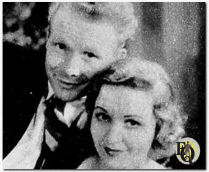 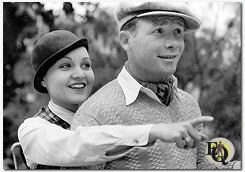 Above left: Torchy's Busy Day (Fox, Oct 2. 1932) - Educational, with Ray Cooke, Marion Shockley, Edmund Breese, Franklyn Pangborn, Cornelius Keefe, Henry Golden and Charlie French. Torchy has the happy faculty for creating action and embarrassment out of which humor is spring. Always the prize blunderer, he is at the same time the happy fixer - even to mending your disposition. Worth an evening anytime. Above right: Torchy Rolls His Own |
|
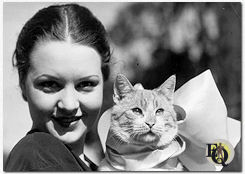 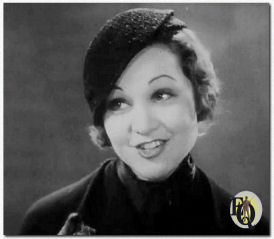 Above left: Marian in a promotional photo for Torchy's Kitty Coup Above right: Torchy Turns Turtle (Fox, Apr 23. 1933) was the 10th (of 12) in the Educational Torchy series. It tells of a dumb, but innocent office boy who strives to make a hero of himself in the eyes of his boss by joining his boss' lodge, the Royal Order of Turtles. Instead he becomes mixed up with a gang of Bolsheviks who try to steal a secret formula from his employer. How Torchy mistakes the gang for the initiation party of the Turtle lodge, and how Torchy beats the gang at their own game makes nothing short of hilarious screen fare. Edmund Breeze is again seen as the employer with Marian Shockley as his eligible young daughter and, of course, in love with Torchy. |
|
|
Sewell Ford published a number of stories through the years of roughly 1910
to 1920 about a red-haired orphan named Torchy who lived in New York City
and moved from job to job. The Torchy character was portrayed first in
silent films by Johnny Hines. Educational
stepped back in. In a series of Torchy comedies where,
apart from her first Torchy film (6th in the series) where she briefly
appeared as Marjorie, she
played the role of Vee Ellins
opposite Ray Cooke's Torchy with titles such as Torchy's Two Toots (Educational, Jun
6. 1932),
Torchy's Busy Day (Fox,
Oct 2. 1932), Torchy Rolls His Own (Fox,
Nov 20. 1932),
Torchy's Kitty Coup
(Fox,
Jan 22. 1933), Torchy Turns Turtle
(Fox,
Apr 23. 1933), Torchy's Loud Spooker
(Educational, Jun 25. 1933), and Trying Torchy Out
(Aug 1933).
*** In December 1932 (right after filming Torchy's Kitty Coup) Shockley became a 1932 WAMPAS baby star. The WAMPAS Baby Stars was a promotional campaign sponsored by the Western Association of Motion Picture Advertisers in the United States, which honored thirteen young women each year who they believed to be on the threshold of movie stardom. They were selected from 1922 to 1934 and honored at a party called the WAMPAS Frolic. Those selected were given extensive media coverage. |
|
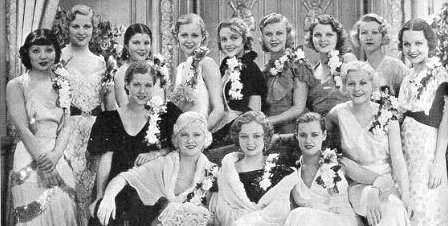 Above: Back, left to right: Toshia Mori, Boots Mallory, Ruth Hall, Gloria Stuart, Patricia Ellis, Ginger Rogers, Lillian Bond, Evalyn Knapp, Marion Shockley. Front left to right: Dorothy Wilson, Mary Carlisle, Lona Andre, Eleanor Holm, Dorothy Layton. |
|
|
She fell completely for the theatre. On January 22. 1933, Bridal Wise by Albert Hackett and Frances Goodrich was shown in El Capitan, Los Angeles, this comedy, which with a different cast was already running on Broadway, was presented by Henry Duffy starring Lois Wilson, Tom Moore and Matt Moore and touted as a "laugh-out-loud love triangle" also featuring Blyth Daly, Jay Ward, Grayce Hampton and Marion Shockley. Messrs. Trebitsch and Parker offered Romance Collect (Oct 1933) by Kerry Shaw at the Hollywood Music Box, L.A. starring Walter Pidgeon. Marian Shockley, came in for plenty of attention; she was described as "a fine leading personality who can well be used on the screen". Other cast members included Claudia Coleman, Gertrude Short, Herbert Evans, Harry King, Dorothy Randal, F. R. Wilson, Harriet Lorraine and Violet Axzelle. She became one of the chief attractions of the International Players at the Vancouver theatre (1934) where she performed in plays as Believe me, Mr. Xantippe (March 1934) and Three Cornered Moon (1934) in which she played the role Claudette Colbert played in the movie. Marion gave in to the advances of co-star John Gordon Barry Thomson, a stage actor, and so they married on February 15. 1934 in Whatcom, WA. She and her husband both starred in a stage company at the Vancouver Theatre. An Australian newspaper called it likely that the company would tour the East and Australia (Apr 1934). Jack Thomson, son of Dr. and Mrs. Barry Thomson of Melbourne, decided to go for a stage career when he was still a small schoolboy. At 16 he went to London to the Royal Academy of Dramatic Art; at 17 he got his first leading role. This was followed by engagements in America, Australia and film work in Hollywood, which did not appeal to this young actor as much as legitimate acting. An artist who painted her portrait introduced her to a Theater Guild official-result, reportedly parts in two Broadway productions. She played a minor part (Gretl) in a two-week, out-of-town tryout by the Theatre Guild of the Ladislas Fodor comedy Love is not Simple at the Chestnut Street Opera House in Philadelphia. Leading actors were Ina Claire and Denis King. The production opened November 4. 1935 in Philadelphia and closed there November 16. 1935, failing to arrive in New York. |
|
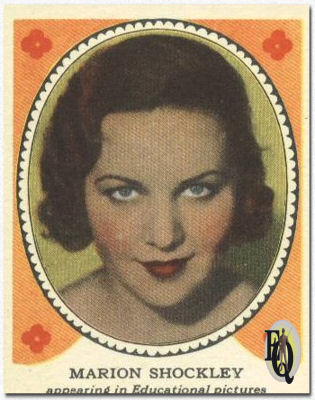 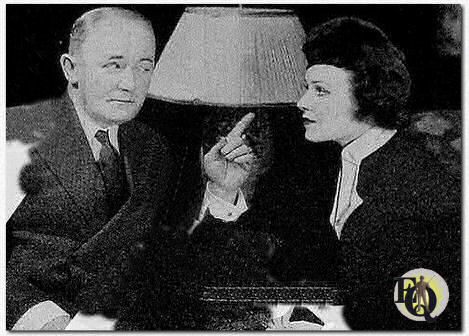 Above left: Marion Shockley "appearing in Educational pictures". Above right: George M. Cohan and Marian Shockley in Dear Old Darling (Mar 1936) |
|
|
She landed a job as an understudy to Ina Claire but her
real Broadway debut came in
George M. Cohan's
Dear Old Darling
(Alvin
Theatre, Mar 2. - 31. 1936).
She went to her interview with selected reading from various plays under her
arm, but when she walked into the office she had a surprise in store for
her. Mr. Cohan and the director asked her to ad lib seven different
imaginary situations portraying sadness, joy, fear and so forth. This was
entirely new to Marian, but she did her best. "Now," said the
director, "in this next situation you are furious. Pretend you're
furious at us for asking you to do all this." Marian WAS furious, lit
in tooth and nail. She told them, in no uncertain terms, exactly what she
thought if their ad-lib system, picked up her coat and stormed out of the
office. The director caught her in the hall and gave her the job. Wealthy retiree Calvin Miller is pursued by Jane Mayo (Marian Shockley), he met on a ship, along with her mother (Theresa Maxwell Conover), both revealed as blackmailers. This complicates Miller's courtship of Widow Collins (Ruth Shepley). Despite the melodramatic premise, the play is promoted as "A Comic Experience". Marian remembers that part of the fun in acting the show was that at each performance one scene was deliberately played ad-lib. Cohan and whoever was on stage with him “would just make it up as we went along.” (10) Despite several tryouts in places like Pittsburgh (Nixon Theatre, Dec 30. 1935), Buffalo (Erlanger Theater, Jan 20. 1936), Malone (Auditorium, Jan. 24.), Philadelphia (Garrick Theatre, Jan 27. & Feb 3.), Cleveland, Detroit, Rochester, Utica, Washington D.C. (National Theater, Feb 10.), and Boston (Colonial Theatre, Feb 17.) it had to settle for a fortnight's stay (16 performances) at New York's Alvin Theatre. (4) |
|
|
Blanche Yurka, Marion Shockley,
Barry Thomson (her husband), Nondas Metcalfe, Jack Hartley, Hope Landon, Joshua' Logan, Conway
Wingfleld, Joseph Ferrer, performed Lysistrata in County Theater,
Suffern, New York (Jul 1936).
First presented in 411 B.C., this ancient comedy
concerns the efforts of Lysistrata, an Athenian woman, to persuade other women
to join together in a strike against the men of Greece, denying them sex until
they've agreed to end the disastrous wars. The season at the Country Theater drew to a close in August 1936 with The Pursuit of Happiness by Alan Child and Isabelle Loudin. Directed by Norris Houghton it featured Dennie Moore, Olvester Polk, Kent Smith, Barry Thomson,... and Marian Shockley. Reportedly as Prudence Kirkland, she presented the audience with a typical New England maid of '76 and the beautiful way in which she won the love of the deserted Hessian soldier, who was quartered at her home, which made for one of the most delightful parts in the play. |
|
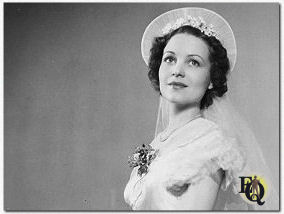 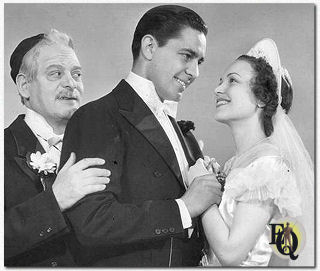 Above left: Marion Shockley as Rosemary in a publicity shot for the play Abie Irish Rose (Little Theater, May 12. - Jun 1. 1937) Above right: Abie (Richard Bond) shows his Irish Rose (Marian Shockley) to Poppa (Alfred White). When on May 13. 1937 New York drama critics tuned their typewriters as Abie's Irish Rose reappeared the comments weren't not favorable "A dull, obvious and excruciatingly common play play that doesn't even maintain the merits of its good intentions" (Herald Tribune); "It would remain completely without importance if it had run 5,000 times, or if it did again" (Sun)... |
|
|
She appeared in an Abie's Irish Rose revival
(Little
Theater, May 12. - Jun 1. 1937)
Author Anne Nichols produced and directed the production which managed a
six-week run. Richard Bond and Marian Shockley (as Rosemary) were the
young couple. Also cast: Alfred H. White, Billy Fay, E. J. Bunkall, Jack G.
Bertin. Sulphur and Molasses (May 1937), was a talking motion picture produced by the Esso Marketers. The production was the work of the organization's motion picture department. It's cast included Richard Bond, Marian Shockley, and Donald H. MacBride. |
|
|
In the summer of 1937 she performed at least in 6 plays during Summer
Theatre with the Lakewood Players in Skowhegan, Maine. Owen Davis Jr. and Marion Shockley
opened with leads in Night Must Fall and Two-Time
Mary. The latter
(Opening Aug 2.)
was a farce in three acts by Owen Davis. Owen and
Marion played the juvenile leads, in this lightly amusing story of a young woman
who cheated to gain her love, lost him by being honest, won him again by
cheating again, and finally held him by fair means. The comedy drama Reno followed on August 9. 1937. Written by John Haggart this was a colorful, interesting panorama of life in a Nevada city. Selena Royle who plays Christine, Willette Kershaw as Olive Smithfield, Grant Mills as Roy, the cowboy, and Charles Farrel, as Jeffrey had the leading roles. Also appearing were Catherine Meskil, A.H. Van Buren, Ben Lackland, Jessamine Newcombe, William David, Marian Shockley, and David Shelley. One week later on August 18. 1937, the company presented The Prodigal Father, a comedy by William M. Barry. Arthur Byron played Ira Whitaker, a middle-aged man who goes to Europe after several years of a loveless marriage and remains there until after his wife's death. He returns to find his son grown up and a stranger to him. Byron tries to regain his son's affection and rescue him from the clutches of a young girl Sherry. Completing the cast were Kathryn Keys, William David, Selena Royle, Marian Shockley, and Dorothy Bernard. One week later the company brought First Lady a play by Katherine Dayton & George S. Kaufman, Marion played Ann Forrester. For their 16th production of the summer season on September 11. 1937 the Lakewood Players at Skowhegan, Me., choose Ah, Wilderness! Eugene O'Neill's comedy with A. H. Van Buren, Dorothy Bernard, David Shelley. John Drew Devereaux, Marjorie Dulin, Andy Doe, Grant Mills, Jessamine Newcombe, William David, Marian Shockley (as Muriel), John Halloran, Winifred Law, Angela Jacobs, Ben Lackland and Donald Dillaway. |
|
| Late December 1937, Walter Winchell predicted the Marion Shockley and Barry Thomson would "tell it to a judge." They did. Thomson would marry actress Ruth Chatterton in 1942. | |
|
Marian
started
fazing out her work in the theater, although in February 1938 she played the lead in Censored at
the 46th Street Theater, a melodramatic comedy by Conrad Setter and Max Marcin and presented by Al Woods.
The story was daring. Getting the necessary backing from a gangster,
playwright-producer Arthur Redmond (Frank Lovejoy) puts his play
Censored on Broadway with graphic scenes of war in the trenches and sex
in the French brothels. Hauled into court after complaints from the
crusading Miss Clutterbuck (Carolyne Norton), Redmond and the cast are
acquitted under the proviso that Miss Clutterbuck rewrite the offensive
parts of the play. Her version excludes all the sex and portrays the
trenches with blooming flower pots and fresh green grass instead of mud. The
result is so awful the actors go on strike. Opposite Frank Lovejoy, Marion played
Millicent Redmond. According to one critic she played a girl who has gone
tremendously wrong and prompted the following comment: "As a bad girl she is
charming."
The comedy originally presented by the Federal Theatre Project in
California quickly
closed. The Inner Light, a drama in 3 acts presented at the Country Playhouse, Westport, Conn. July 18. 1938 was pretty grim stuff about a brilliant but discredited doctor who claims to have discovered an injection to cure the blind. Marian Shockley was convincing as the interloper. (Hugh Marlowe also appeared in this play). |
|
| After appearing in several shows which came off bruised by bouts with dramatic critics and the public, she grew disenchanted. "I decided," she said, "that no one but children of wealthy parents could afford to work in the theater. I went into radio." She helped a friend make a recording for a radio show, by impersonating Judy Garland; Phil Baker promptly engaged her to impersonate Katherine Hepburn on his show, and there she was, in radio. She was an immediate success. Within hours after her first audition, at CBS, she was cast opposite Chester Morris in a dramatic skit on a Kate Smith show. Parts came thick and fast afterward. | |
| Confining her acting effort more and more to radio she was heard on The Kate Smith Hour (CBS, Jan 1939), Doctor Christian (CBS, Jan 24. 1939, "Chains"), The Guiding Light (NBC, 1937 - ), Aunt Jenny's Stories (CBS, Feb 1939 - ), ... In May 1939 she was added to Phil Baker's stooge ranks on Honolulu Bound (CBS) otherwise known as The Phil Baker Show, a radio musical comedy which also featured the Andrew Sisters. |
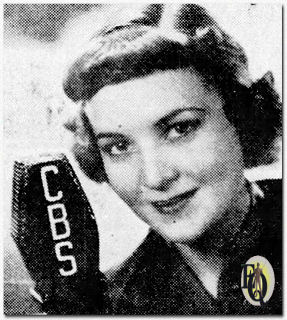 |
| Right: Marion Shockley was heard in character portrayals in Aunt Jenny's Stories. Mondays through Fridays at 10:45 a.m. (CBS, Oct 1939) | |
|
Television, still a fairly unpopular medium, also beckoned starting August 1939 NBC televised four stage
successes. One of those Streets of New York included George
Coulouris, Norman Lloyd, and a small role for Marian Shockley. Broadcast on
Thursday, August 31. 1939 – it’s among the earliest TV footage from the
United States known to exist! In 1939, at CBS, producer Zachary was gathering his team for the radio version of The Adventures of Ellery Queen. In order to attract a more female audience, Dannay, Lee and Zachary added a new character to the stories: Ellery's secretary Nikki Porter. George Zachary, then the director of the show, didn't want Marion. George argued that Marion just wasn't right for the part, but three other Network officials outvoted him and the Shockley girl got the role, thus becoming the first actress to portray Nikki Porter, Ellery's secretary and low-key love interest. In the "Gum-Chewing Millionaire" she's a blonde professional typist who gets asked to work on Ellery's manuscripts. She then applied for the job of personal secretary. Marion and George Zachary, the radio series' producer, were secretly married on October 5. 1939, and Zachary made sure that Nikki was written out of the scripts during the weeks the newlyweds were off on their honeymoon. She played Nikki both opposite Ellery Queen actors Hugh Marlowe, Carleton Young, and Sydney Smith. |
|
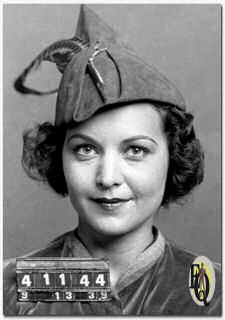 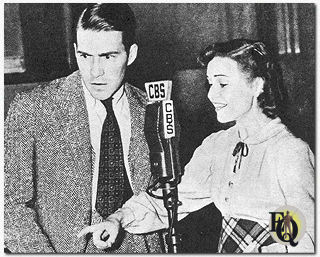 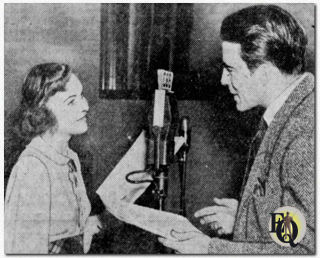 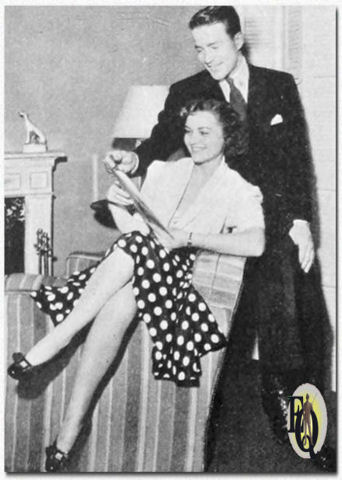 Above: Hugh Marlowe and Marion Shockley. "Here is Ellery Queen, famous CBS sleuth, and his faithful secretary Nikki. Each week they investigate a new mystery adventure and listeners are called upon to figure it out before the solution is dramatized following the intermission (Dec 1939)." |
|
|
In March 1940, she played opposite Bud Collyer in at
least 7 episodes of Superman
(WOR)
with
Santos Ortega. On assuming the Nikki role when it was written into the show in May of 1940, Marion was surprised to find herself reading such strictly unfeminine lines as "turn on the heat and make the palooka sing!" The authors were quite as surprised as she to find they had so submerged themselves in crime-world jargon that they had lost their feeling for girlish expression. Their lapse was forgivable in that sex is of minor importance in detective mystery novels. However, now Ellery was on the air, the need for bona fide feminine interest was urgent. Marion and the writers decided to spend an evening together and talk the thing over. Outside of Marion's getting a run in her stocking, they had such a very good time they forgot to talk shop at all. However, the evening bore fruit anyway. In the next script Nikki got a run in her sock and said things much in the same way that Marian might. Subsequent evenings together brought similar gratifying results. Playing Carol Carroll in Manhattan at Midnight (NBC-Blue, Aug 1940) Marion played a young stage performer who learns about dramatics and love from a dramatic critic. She was heard in "Second String" (Aug 7.) and in "Christmas in July" on December 18. 1940. As late as December 1941 she was presented as a regular member of the cast. In February 1941, Variety reported that Marian Shockley had a regular role in Mother o'Mine. In October 1941 she returned from Caribbean cruise with her husband, "almost completely recovered from injuries from recent spill from horse". But it was only when, in 1942, Zachary left Ellery Queen to become the program chief for the radio bureau of the Office of War Information they acknowledged their marriage. |
|
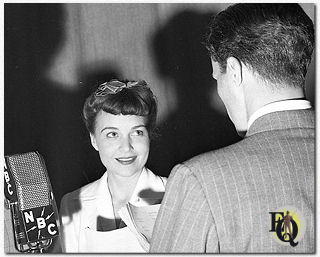 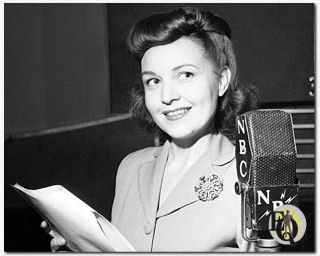 Above left: Marion Shockley (Nikki) opposite Carleton Young as Ellery Queen in a photo for episode 92 "The Midnight Visitor" (1942) Above right: Marion Shockley as Nikki Porter (ca. 1945). |
|
|
In July 1943 she was reportedly "an expecting mother", however she and
George were not blessed with a child.
|
|
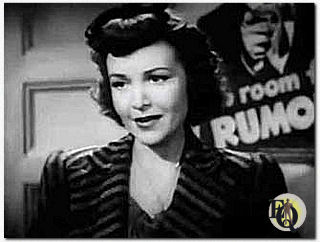 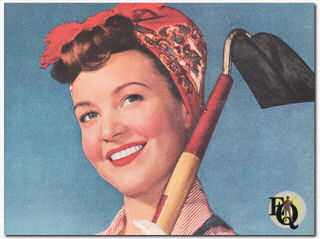 Above left: Marion Shockley in Stage Door Canteen (United Artists, Jun 24. 1943) American World War II film with some musical numbers and other entertainment interspersed with dramatic scenes by a largely unknown cast. Above right: Marian Shockley on the cover of Radio Mirror (May 1943). |
|
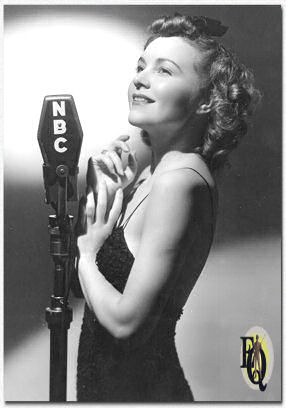 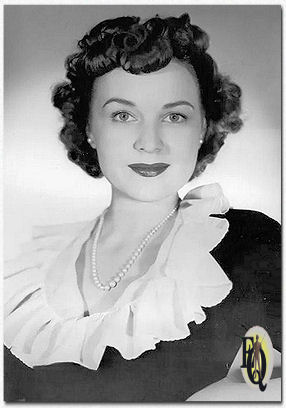 Above: Publicity shots for the NBC radio show The Adventures of Ellery Queen (1943 and 1944) with the lovely Marian Shockley. |
|
|
On radio she also had a roles in: Mr. District Attorney; We, the People; Abie Irish Rose (1942 - 1944) with Richard Coogan, Sydney Smith and Bud Collyer (!); Romance (CBS, Feb 29. 1944, "A Lady in Love"); The Sportsmen's Club (NBC, Jul 22. 1944, "Fore"); ... In January 1945 Manfred B. Lee decided to break with the past on the Ellery Queen show and fire the actress who'd played Nikki for almost five years "...whose vacuity and lack of ability had caused the role to dwindle almost to the vanishing point." (Manny Lee, Apr 11. 1945). Marian got other roles on radio: Truth or Consequences (x), Theatre of Today (CBS, Jun 1945) as "The Quaker Girl"; The Adventures of the Falcon (Mutual, Jul 3. 1945); My True Story (ABC, - 1946 -); and as regular in Road of Life (NBC, 1945 - 1947). Marion was in an episode of Murder At Midnight, "The House That Time Forgot" (WJZ, Aug 16. 1946) in which a couple buy a house with invisible tenants, and time ran backwards too! A good story of the supernatural. |
|
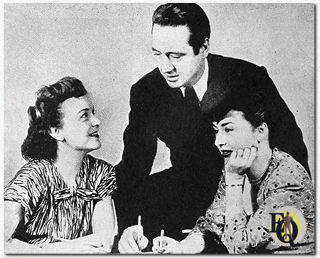 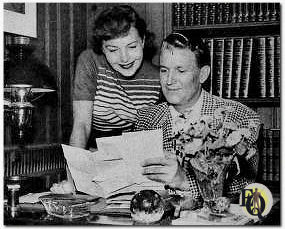 Above left: James Meighan, of Mutual's Adventures of the Falcon, debuted in the title role of the Falcon (Mike Waring) on July 3. 1945. The first episode found Mike involved with a Nazi spy and murder ring. His girl friends were played by Marion Shockley and Mitzi Gould. Above right: Marian Shockley and Bud Collyer. "Never on to shirk his chores or what he considers his duties, Bud is a conscientious mail answerer" (Dec 1951). |
|
| Her second marriage ended soon after the war and late in 1946, in Maryland, she remarried ** Clayton "Bud" Collyer (Jun 18. 1908 - Sep 8. 1969) the radio star who starred in Superman. Despite having already worked together several times, they only fell in love during their collaboration on Road of Life. That was May 1945, Bud as M.C. and she replaced Maybelle Prindiville who left the series to marry. They also worked in the longest running soap The Guiding Light. They had a eighteen-hour honeymoon in Atlantic City since they both had to get back to New York for radio dates. The couple settled down in the big stone house in Greenwich, Connecticut. | |
|
Three of radio's best-known
performers - Karl Swenson, Mary Shipp and Marian Shockley - headed the cast
of "Pardon, My Heart's Showing", an original drama by Joseph Ruscoll. on
Columbia's Silver Theater on July 13. 1947. Bud Collyer was the
announcer. Marian was also heard on Molle Mystery Theatre (NBC, Oct 31. 1947, "Now You See Her, Now You Don't") |
|
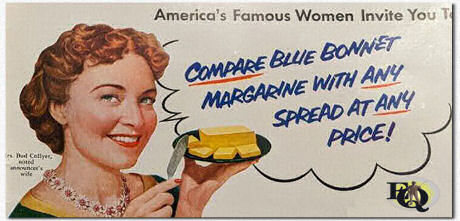 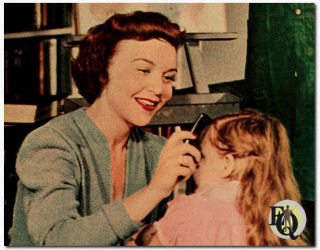 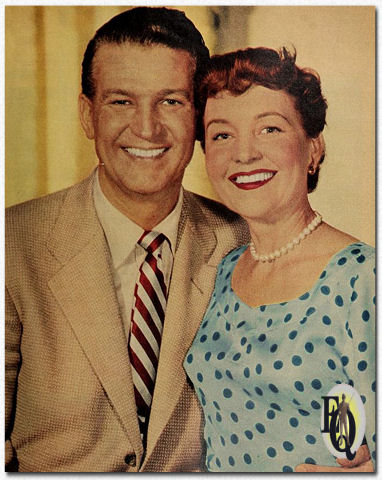 Top: Marion also appeared in the 1951 Sandwiches Are Nutritious Too Blue Bonnet Margarine Plus Sandwich Manual. Above left: In Road of Life, Marion Shockley plays Carol Brent, seen here with her daughter Janie. Marion plays Dr. Jim's beautiful, petite wife. All her strength of character and bitter experience are needed to make her marriage a success (Book Reader Image, 1952). Above right: Bud Collyer and his wife Marian Shockley in 1954. |
|
|
In the 50s they both made the
transition to TV. Collyer as announcer both appearing on radio and TV.
Marion also appeared in the 1951 printed ads for Blue Bonnet margarine
and she did some work in television series such as The Big Story
(NBC, Aug 4. 1950),
Armstrong Circle Theater (NBC, Feb 19.
1952)
episode "The Hat from Hangtown" by Helen Papashvily; with Mabel Taliaferro,
Paul Huber, Marion Shockley, Elizabeth Watts, Nell Harrison, Tess Sheehan,
Kate McComb, Joanne O'Donnell. On December 14. 1952 "The Hills are Green", a whimsical tale of Norman Rockwell's tribulations upon his move to a small town in Vermont, was presented on TV's Hallmark Hall of Fame (Sarah Churchill), it featured Robert Wright, Marian Shockley, Frank Gunther and Bobby Hunter. Albert McCleery was the director. She appeared again in (Hallmark Hall of Fame) "The Other Wise Man" airing April 5. 1953. Between October 1954 and May 1955 had a running part as a schoolteacher in The World of Mr. Sweeney (NBC, min. 7 episodes) with Charlie Ruggles, Glenn Walken and Helen Wagner. Ruggles called her "Miss Marian." After these broadcasts, she retired from acting with occasional reappearances. According to TV Radio Mirror she had a brief uncredited fling in television, playing one of the mothers in “The Night America Trembled,” a television dramatization of the public reaction to the 1938 radio broadcast of "The War of the Worlds" that aired September 9. 1957, as an episode of the CBS series Westinghouse Studio One. In an interview Bud admitted he liked to see his wife return to acting if the right thing came along: "I believe that anyone who has talent and holds back from using it is never entirely satisfied. Marian had such a strong sense of responsibility to all of us that she put it before everything else." (TV Radio Mirror, Sep 1958) |
|
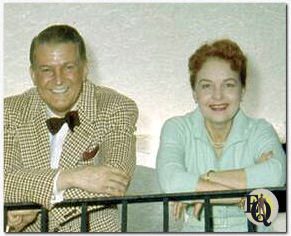 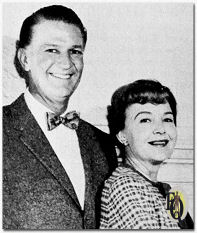 Above left: Bud Collyer with Marion enjoying some time off at home (1960s). Above right Marion Shockley with her husband Bud Collyer in 1961. |
|
|
On Tuesday, June 4. 1968 the guest panelists on TV's To Tell The Truth were the wife and daughter-in-law of host Bud Collyer. After her husband died (Sep 8. 1969) she took up various humanitarian causes and at one time served on the board of The Spence-Chapin Adoption Agency. Marian passed away December 14. 1981 in Los Angeles, aged 73 years. |
|
|
Notes: * Several sources mention either 1908 or 1911, however an official 1930 census report mentions Marian as being 21 years old ... Her birthday is confirmed by a newspaper clipping from 1908. ** Some sources claim they were married in 1946 or 1948 on Bride and Groom, a radio audience participation show (from the West Coast). Several small newspaper reports place the marriage date around late 1946. Furthermore, in several interviews (Jan 1948) with the family in magazines this remarkable fact was never mentioned. The same logic disproves that other marriage date (Jun 14. 1952). *** Torchy's Ghost featured both Ray Cooke and Marian when it went into production in March 1933. Confirmation needed as it has the same title as a 1922 short. Presumably the "sensitive" Co-Co clan from the version of 1922 was replaced by the Turtle Lodge in Torchy Turns Turtle. For Torchy's Big Lead production began in April 1933, advertised as the last in the series it's the working title for Trying Torchy Out. All titles are as they were in the 30s movies, later when they appeared on TV, some titles were changed incorrectly. All dates for movies are for the first US release. All dates for TV programs are original first airdates. All dates for (radio) plays are for the time span the actor was involved. Facts in red still need confirmation. |
|
|
Click on Uncle Sam if you think you can help out...!
|
|
|
Other references (1) Wikipedia (2) IMDb (3) Marian S. Collyer, an Actress And Widow of TV Personality, The New York Times, December 18. 1981 (4) American Theatre: A Chronicle of Comedy and Drama, Gerald Bordman, 1930 - 1969 (5) IBDB Marian Shockley credits (6) OTRRPedia (7) Radiogoldindex and Radiogoldindex (8) RUSC (9) Kappa Alpha Theta Journal, Vol. 45 no.1 - November 1930 (10) George M. Cohan: the man who owned Broadway John McCabe, 1973 (11) Playbill.com (12) Spectra - IOBDB Additional video & audio sources (1) Stars Tom Brown, Dorothy Layton, Marion Shilling, June Clyde and Marian Shockley complete a giant jigsaw puzzle at Universal City in California Short Movie, March 20. 1933 (2) Torchy series (1932 - 1933) complete series of 12 Educational Torchy comedies, as of the 6th Marian was in them. (Joseph Blough,YouTube) (3) Streets of New York (1939): Earliest Surviving U.S. TV Footage 2 (4) 1932 WAMPAS girls in fashion show (glamourdaze - YouTube) (5) Dear Old Darling audio clip from the play, clip starts (5:30) with Marian (Jane) in it ... (BT McNicholl, YouTube) |
|
|
This actor profile is a part of
Ellery Queen a website on deduction.
The actor above played Nikki Porter in
an Ellery Queen radio series.
Click Uncle Sam if you think you can help
out...! Many of the profiles on this site have been compiled after very careful research of various sources. Please quote and cite ethically! |
|
|
Page first published in 2010 Version x2.1 - Latest update April 23. 2025 |
|
 b a c k
t o L i s t o f S u s p
e c t s
b a c k
t o L i s t o f S u s p
e c t s
|
|
| Introduction | Floor Plan | Q.B.I. |
List of Suspects | Whodunit? | Q.E.D. | Kill as directed | New | Copyright Copyright © MCMXCIX-MMXXV Ellery Queen, a website on deduction. All rights reserved. |